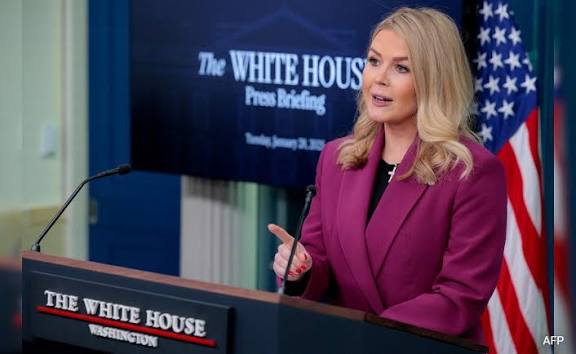Karoline Leavitt Promoted to West Wing Office: youngest White House press

At the age of 28, Levit is the youngest person to serve as a press secretary, who has caught Trump’s eye. Today we will discuss about Karoline Leavitt Promoted to West Wing Office: youngest White House press
Karoline Leavitt Promoted to West Wing Office: youngest White House press
Karoline Leavitt’s ascent to a key West Wing office marks a notable milestone in the Trump administration’s communications strategy. At a relatively young age, Leavitt has moved into one of the most visible roles in government: as press secretary with direct proximity to the president. This development — both symbolic and practical — signals growing confidence in her capacity to shape messaging, manage the press corps, and project the administration’s narratives. In this article, we trace Leavitt’s background, analyze the significance of her new West Wing office, consider challenges she may face, and reflect on the broader implications for the White House press operation.
Background: Who Is Karoline Leavitt?

Early life and education
Karoline Claire Leavitt was born August 24, 1997, in Atkinson, New Hampshire. She studied politics and communication at Saint Anselm College, graduating in 2019. While in college, she was active in student media and broadcasting efforts.
Early political engagements
Leavitt’s early Washington exposure came via an internship in the White House Office of Presidential Correspondence. She later became associate director in that office and then moved into the White House press operations during the Trump administration’s first term.
After 2020, she served as communications director to Rep. Elise Stefanik (R-NY) and then launched a campaign for Congress in New Hampshire. She won the GOP primary in a 10-candidate field but lost the general election to incumbent Democrat Chris Pappas. From there, she became a national spokesperson and press lead for Trump’s 2024 campaign.
Appointment as White House Press Secretary
In November 2024, Donald Trump announced Leavitt as his pick for White House Press Secretary. At 27 years old, she became the youngest person ever to hold the office. She formally began the role when Trump was inaugurated for his second term in January 2025.
Her first press briefing was on January 28, 2025, lasting nearly 47 minutes as she engaged directly with reporters. In that session, she pledged greater openness to nontraditional media (podcasters, influencers) and emphasized that both she and Trump would speak frequently.
Promotion to a West Wing Office: What Changed?
The Announcement & the Office
Media outlets recently reported that Leavitt was promoted into a prime West Wing office that had been vacated by a deputy communications aide, Taylor Budowich. That office is considered among the most prestigious spaces in the West Wing due to its proximity to the Oval Office, its size, and its symbolic weight as a seat of access and influence.
Thus, her new setting moves her physically and institutionally closer to the center of executive operations. It also implies that some responsibilities previously handled by Budowich may now fall under her purview. Observers see this as a “vote of confidence” in Leavitt’s performance and trust from the administration.
Signaling Power and Status
In the culture of the White House, the allocation of offices is not just logistical — it’s deeply symbolic. Proximity to the president, the size of a room, and access to corridors matter. A larger, more centrally located office helps portray authority and influence within the communications hierarchy.
Leavitt occupying that space also conveys that she is no longer a passive communications agent but a central figure within messaging strategy. It suggests she may have a more direct hand in shaping narratives, coordinating with other senior aides, and serving as a gatekeeper between media and the president.
Implications & Expectations
Expanded Role
With the move, Leavitt may absorb parts of what Budowich handled — possibly portions of speechwriting, message coordination, or media logistics. Observers expect her voice to be amplified within internal White House deliberations. Managing the press corps and guiding the administration’s narrative may now rest more heavily on her.
Her new responsibilities may also include supervising accreditation decisions (which media get to cover briefings) — a topic already under debate in the current White House. The White House has recently indicated that it would exert more control over press pool membership.
Credibility, Scrutiny, and Challenges
While this promotion boosts visibility and prestige, it also intensifies scrutiny:
-
Youth and Experience
At 27–28, Leavitt is younger than virtually all her predecessors. Critics may question whether she has the depth of experience to manage press crises, adversarial reporters, and thorny optics. The relentless pressure of the press secretary role means she will face tests in real time. -
Tone and Style
Leavitt has already been associated with an aggressive, combative tone in communications. Some see this as playing to the base; others warn it may exacerbate tensions with journalists and erode goodwill. She must balance assertiveness with diplomacy to maintain press access and credibility. -
Media Relations & Access
Her stated intent to open up accreditation to influencers, podcasters, and nontraditional outlets is ambitious. But the press corps may resist changes to established norms and hierarchies. Handling resistance, complaints, and fairness questions will be delicate. -
Crisis Management
Every administration must confront breaking news or scandals. Leavitt’s inexperience on the national stage means missteps are possible — misstatements, contradictions, or communication gaps could tarnish her standing and that of the White House.
Historical Context: Age, Office Dynamics, and Precedents
Young Press Secretaries in History
Leavitt’s youth is not entirely without precedent — previous press secretaries have assumed office in their early 30s — but she sets a record. The prior youngest was Ronald Ziegler, who became press secretary at 29 under Richard Nixon. In the Clinton era, Dee Dee Myers was among the youngest women to serve in the role (in her early 30s). But to assume the office in one’s late 20s is unprecedented in modern times.
Historically, the size and location of press secretary offices reflect internal power structures: those closer to the Oval Office or superconnected corridors often suggest that person is consulted, looped in, and influential. Leavitt’s shift into such a space underlines that.
Shape of the Trump Press Operation
Under Trump’s first administration, press secretaries sometimes played secondary roles to the president’s direct communication via rallies, social media, and off-the-cuff remarks. Trump occasionally bypassed the podium entirely. In his second term, this pattern may continue, but Leavitt’s closer role indicates an attempt to reassert a structured press function while preserving the president’s unmediated link to the public.
The move could also be viewed as consolidating a more centralized messaging apparatus, reducing the fragmentation sometimes seen among communications aides and spokespeople.
Strategic Opportunities
Shaping Narrative Coherence
Leavitt’s new base positions her to help unify messaging across departments — coordinating with communications staff at Justice, State, Homeland Security, and other agencies to align language with presidential priorities. This centralization could reduce confusion and conflicting statements.
Digital & Nontraditional Media Integration
Leavitt has already signaled that she wants to expand access to new media — such as podcasters, social media influencers, and digital-native news outlets. As she moves into the West Wing, she may institutionalize mechanisms for their inclusion, thus broadening the administration’s communications reach beyond legacy media.
She has also expressed openness to restructuring briefing room norms — including a “new media seat” to reflect trending media formats.
Symbolic Leadership & Messaging Discipline
Occupying a major West Wing office enables Leavitt to project greater authority to her team and to external observers. It may help enforce discipline in message lines, reduce internal frictions, and centralize decision-making. Her physical presence in core corridors — near advisors, policy teams, and senior staff — may allow her to intervene early in message development and crisis response.
Risks & Countervailing Pressures
Overreach & Backlash
Some may view the move as overreach — consolidating too much control in one communications figure. Other aides, senior officials, or department communications shops may bristle at perceived encroachment. Leavitt will need to navigate interpersonal dynamics carefully.
Credibility Tension with Press Corps
If the press secretary is seen as too partisan or adversarial, press access may be constrained in pushback. Journalists may test her with tough questions, demand clarifications, or challenge statements, putting her performance under daily microscope. A single gaffe or contradiction could be magnified.
Workload & Burnout
The role of press secretary is among the most demanding in government — 24/7 possible media events, evolving crises, traveling demands, coordination across agencies, and constant pressure. For someone young and relatively new, managing workload, maintaining composure, and sustaining consistency are serious challenges.
Media Narratives & Skepticism
Skeptics may interpret the promotion as political theater — signaling loyalty rather than merit. Leavitt must build a track record of competence to offset criticisms of inexperience or tokenism.
What to Watch Moving Forward
-
First Moves in the Office
How Leavitt restructures her staff, deploys communications strategy, and interfaces with policy teams will signal how serious this promotion is operationally. -
Briefing Room Dynamics
Will she continue to host extensive question sessions, bring on nontraditional media, or experiment with transparency? Will she shift the tone — more confrontational or more disciplined? -
Messaging Consistency
Tracking how well her statements align with presidential actions, policy shifts, and internal memos will be key to her credibility. -
Crisis Handling
Her performance during emergencies, scandals, or breaking news will test her mettle more than any planned event. -
Institutional Reaction
Observers should watch for friction or support among senior staff, communications teams in other departments, and external stakeholders.
Conclusion
Karoline Leavitt’s promotion to a West Wing office is more than a change of furniture — it is a milestone in her trajectory and a signal of how the Trump administration intends to manage communications. The move grants her increased proximity to power, greater control over messaging, and a more visible posture. At the same time, it raises the stakes: the press secretary’s job is unforgiving, and Leavitt’s youth and relative inexperience make this a high-risk, high-reward moment.
If she succeeds, Leavitt may reframe perceptions of the role, usher in new norms in media access, and set a communications standard for this presidency. But missteps could be amplified, and her capacity for disciplined messaging under pressure will determine whether this promotion becomes a defining asset or a cautionary tale.
How useful was this post?
Click on a star to rate it!
Average rating 0 / 5. Vote count: 0
No votes so far! Be the first to rate this post.
About the Author
usa5911.com
Administrator
Hi, I’m Gurdeep Singh, a professional content writer from India with over 3 years of experience in the field. I specialize in covering U.S. politics, delivering timely and engaging content tailored specifically for an American audience. Along with my dedicated team, we track and report on all the latest political trends, news, and in-depth analysis shaping the United States today. Our goal is to provide clear, factual, and compelling content that keeps readers informed and engaged with the ever-changing political landscape.




